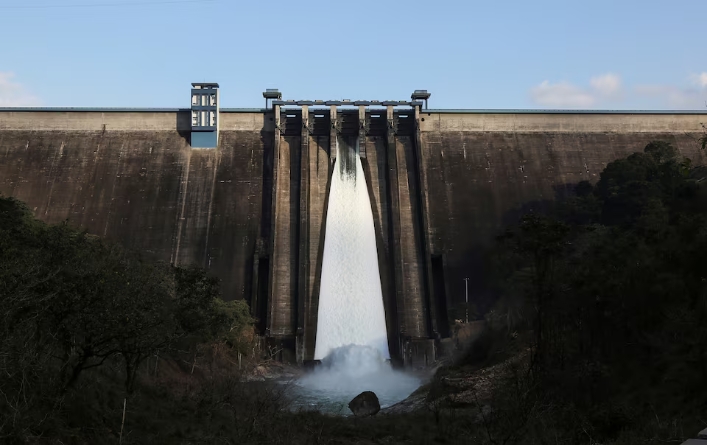
The 16.3% drop in generation from the country's biggest clean energy source coincided with the share of renewables in power generation sliding for the first time since Prime Minister Narendra Modi made commitments to boost solar and wind capacity at the United Nations climate talks at Paris in 2015.
Renewables accounted for 11.7% of India's power output in the year that ended in March, down from 11.8% a year earlier, a Reuters analysis of daily load despatch data from the federal grid regulator Grid-India showed.
India is the world's third-largest greenhouse gas emitter, and the government often points to lower per-capita emissions compared to developed nations to defend rising coal use.
A five-year low in reservoir levels means hydro output will likely remain low during the hottest months of April-June, experts say, potentially boosting dependence on coal during a period of high demand before the monsoon starts in June.
K. J. Ramesh, former chief of the Indian Meteorological Department, said there is increased chance of high rainfall during the annual monsoon this year, but any impact on hydropower output would not be visible before July.
"When hydro increases due to good rainfall, it should be used to reduce dependence on thermal," he said, adding that erratic rainfall means India should not count on hydro as a reliable power source in the future.
DECLINING SHARE
Hydro's share in India's total power output fell to a record low of 8.3% during the fiscal year ended March 31, Grid-India data showed, compared with an average of 12.3% in the 10 years through 2020.
The share of hydropower has steadily declined in recent years amid a slowdown in addition of new capacity, with other sources including coal, solar and wind gaining share.
The lightest rainfall since 2018 meant reduced water levels in reservoirs, pushing annual hydro generation to a five-year low of 146 billion kilowatt-hours (kWh).
Advertisement · Scroll to continue
Report this ad
Meanwhile, power generation from coal and lignite in 2023/24 rose 13.9%, outpacing the 9.7% increase in renewable sources' output, data from the grid regulator showed. Total power generation rose 10.3% in 2023/24, Grid-India data showed.
India missed a 2022 target to install 175 gigawatts (GW) of renewable energy, and remains 38.4 GW short of that goal, with Grid-India data showing India's dependence on fossil fuel for power hit a five-year high of 77.2% in 2023/24.
India's addition of renewables slowed to a five-year low in 2023.
Globally, hydropower output fell for only the fourth time since 2000 due to lower rainfall and warmer temperature brought about by the El Nino weather pattern, according to energy think tank Ember. Hydro output in India, the sixth-biggest hydropower producer, fell nearly seven times faster than the global average, Ember data showed.
The Reuters Power Up newsletter provides everything you need to know about the global energy industry. Sign up here.Reporting by Sudarshan Varadhan and Cassandra Yap; Additional reporting by Sarita Chaganti Singh in New Delhi and Colleen Howe in Beijing; Editing by Christopher CushingOur Standards: The Thomson Reuters Trust Principles., opens new tab
Purchase Licensing RightsSudarshan VaradhanThomson Reuters
Sudarshan currently reports on the evolving energy landscape in Asia, as the region tries to strike a balance between ensuring reliable electricity supply and fighting climate change. In his previous avatar, he reported on sanctions-era global trade, human rights violations, labor movements, environmental offences and natural disasters in India for six years. During his nine years as a Reuters correspondent, he has attempted to lend a global perspective to small-town issues.
Read Next
BusinesscategoryRecord wildfires hit Venezuela during climate-driven Amazon drought
Venezuela is battling a record number of wildfires, according to data released on Monday, as a climate change-driven drought plagues the Amazon rainforest region.
The SwitchcategoryVirginia regulators approve Dominion Energy solar projects
Virginia utility regulators on Friday approved new solar projects with a total of 764 MW electricity capacity that will expand Dominion Energy's clean energy portfolio in the U.S. state.
BusinesscategoryExclusive: China power firm GCL revives LNG ambition after solar spin-off
Privately-run Chinese power company GCL Holdings is rebuilding a natural gas business after offloading hundreds of solar installations to set up gas import capacity and a trading operation, company executives told Reuters.
MarketscategoryNippon Steel emphasises its 'deep roots' in the US as it pursues U.S. Steel deal
Nippon Steel intends to pursue its proposed acquisition of U.S. Steel and wants its "deep roots" in the United States to be recognised, its new president said - remarks that come after U.S. President Joe Biden expressed opposition to the deal.
BusinesscategoryCanada 'not interested' in investing in LNG facilities, energy minister says
Canada is not interested in subsidizing future liquefied natural gas (LNG) projects, including electrification of projects currently in the works, Energy and Natural Resources Minister Jonathan Wilkinson said in a television interview on Sunday.
DECLINING SHARE
Hydro's share in India's total power output fell to a record low of 8.3% during the fiscal year ended March 31, Grid-India data showed, compared with an average of 12.3% in the 10 years through 2020.
The share of hydropower has steadily declined in recent years amid a slowdown in addition of new capacity, with other sources including coal, solar and wind gaining share.
The lightest rainfall since 2018 meant reduced water levels in reservoirs, pushing annual hydro generation to a five-year low of 146 billion kilowatt-hours (kWh).